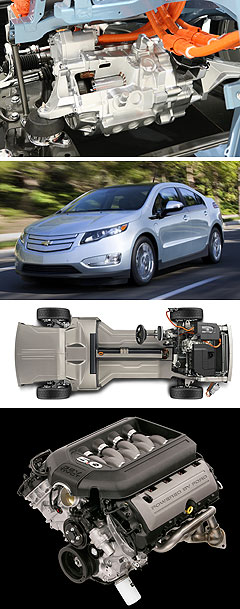Make / Model Search
News - NissanElectric cars power into engine awardsOn top of the world: Fresh from winning the 2011 European Car of the Year award, the Nissan Leaf's electric motor has been named in the 2011 Top Ten Engines. Nissan Leaf and GM Volt electrify engine judges to make Ward’s top ten9 Dec 2010 ELECTRIC vehicles have been recognised for the first time in Ward’s annual gongs for great engines, with the powertrains from Nissan’s all-electric Leaf and General Motors’ range-extender hybrid Volt both winning a place on the 2011 Ward’s 10 Best Engines list. But the judges from Ward’s Autoworld magazine in the United States proved it wasn’t all about fuel economy by including two 5.0-litre V8s – Ford Mustang GT’s Coyote engine and Hyundai’s Tau V8 that powers its Genesis flagship. No fewer than four six-cylinder engines also made the cut: Audi’s super-charged 3.0-litre TFSI V6 that made its debut in the Audi S4, BMW’s N55 turbo-charged 3.0-litre inline six from the 335i, Chrysler’s new 3.6-litre Pentastar V6 and Volvo’s 3.0-litre turbo inline six from the new Volvo S60. The only conventional four-cylinder engines to rate a mention were Mini’s BMW/Peugeot ‘Prince’ 1.6-litre petrol turbo engine from the Mark II Cooper S and Volkswagen’s 1.4-litre turbo diesel that powers the new Jetta TDI. Most of the attention fell on the new-age electric powertrains that made their debut in the US in the 2011 model year and were drawn from a list of 38 contenders. Ward’s editors praised the all-electric Nissan Leaf and its 80kW AC synchronous electric motor for its conventional car-like feel.  From top: Nissan Leaf's electric drivetrain, Chevrolet Volt, Chevrolet Volt's drive system and Ford Coyote V8. From top: Nissan Leaf's electric drivetrain, Chevrolet Volt, Chevrolet Volt's drive system and Ford Coyote V8.They described the car – recently named 2011 European Car of the Year – as a thrill to drive, and praised the vehicle’s affordable price – $US25,000 with a federal tax credit. “Range anxiety is a hurdle, just like in 1908, when the first Ford Model T buyers worried about finding gas stations,” Ward’s said. “But an electrical socket – ubiquitous in the developed world – is all that is needed for people who want to own and drive a Leaf, while consuming no gasoline and creating zero emissions. As a propulsion system, it truly deserves recognition.” The 111kW electric/petrol Voltec propulsion system of GM’s ‘range extender’ Volt – which will be sold in Australia as the Holden Volt from 2012 – was lauded by Ward’s as “brilliant, a technological masterpiece”. The magazine said that while GM was pulling itself out of bankruptcy, it was developing a car that revolutionised mobility. “Drive the Volt almost exclusively in electric mode and gas stations will become less a part of daily life,” Ward’s said. Running on battery power, the Volt’s electric motor propels the car for about 50-60km, depending on driving conditions, before the 63kW 1.4-litre petrol engine kicks in to power a generator to extend the range to about 600km. Announcing the list, Ward’s editor in chief Drew Winter said the 2011 list was the most diverse in the award’s 17-year history, providing “something for everybody”. With the exception of the Hyundai Tau V8, all of the engines on the list are either already on the Australia market or earmarked for launch here. However, Ford’s Coyote V8 from the Mustang GT is available only in Australia in locally modified, supercharged Ford Performance Vehicles form. In the latest FPV GT, the blown V8 belts out 335kW and 569Nm, compared with the normally aspirated Mustang GT’s 307kW/529Nm. The Nissan Leaf and Holden Volt are scheduled for launch Down Under in 2012, while Chrysler’s Pentastar V6 is due to make its Australian debut in the Jeep Grand Cherokee in February.
 |
Click to shareNissan articlesResearch Nissan Motor industry news |
||||||||||||||||||||||









Facebook Twitter Instagram